When the torrential monsoon rains caused the Indus to break its banks and rage through northern Pakistan, Fawwad Sherwani, a 36-year-old Pakistan Red Crescent Society (PRCS) volunteer from Karachi, immediately joined the relief teams.
Working both in PRCS camps and in the Karachi 'control room', Sherwani helped assess the needs on the ground and communicate that to headquarters. He helped establish routes to get aid to victims via boats, jeeps and helicopters.
An experienced aid worker who has responded to earth-quakes, suicide bombings and cyclones, Sherwani doesn't think too much about the Millennium Development Goals (MDGs) when he puts on his Red Crescent vest and cap and rushes off to an emergency. He just likes to help people and, even though he doesn't get paid, it's his job, what he was trained for.
But as 2011 (the tenth anniversary of the first Year of the Volunteer) begins, global health and political leaders say the consistent efforts of volunteers such as Sherwani are critical to achieving global Millennium Development Goals, a series of eight development targets that governments have pledged to meet by 2015 (see box).
Take the case of polio. Health experts say that volunteer efforts — including the extensive networks of National Red Cross and Red Crescent Societies in countries such as Afghanistan and Nigeria — are one reason why the disease's eradication is now in sight. The network allows vaccination programmes to go the 'last mile,' reaching deep into communities that are often hard for outsiders to access. During a measles campaign in Mozambique's Nampula province, for example, Red Cross volunteers helped achieve a 97 per cent coverage rate, compared to 88 per cent in other rural areas (a critical difference when fighting diseases that develop resistance and spread quickly).
Volunteers are key
With only four years left before the 2015 MDG deadline, there's still a long way to go. Even with polio, and the advances against measles, eradication is far from assured. On issues such as poverty and children's healthcare, there are complex obstacles — natural disaster, desertification, armed conflict, global warming, urban violence, chronic food insecurity, financial crisis — that gets in the way.
With insufficient levels of government and private sector resources available and many challenges in accessing vulnerable communities, many are turning to volunteers as a key resource. As UN Secretary-General Ban Ki-moon said recently, "Achieving the Millennium Development Goals will require the engagement of countless millions of people through volunteer action."
Because they are rooted in their local communities, Red Cross and Red Crescent volunteers are able to bring vaccination, emergency relief or critical drug treatments even to areas of armed violence (Baluchistan province in Pakistan, in Somalia, or in remote areas of Afghanistan, where Red Crescent volunteers help deliver polio vaccine during prearranged 'tranquility days').
Volunteers also have a social impact, which is harder to quantify, but which contributes to community stability and recovery, particularly during conflict. A volunteer for the Red Cross of the Democratic Republic of the Congo, Patrick Zaboninka Mayara travels by bicycle and on foot to deliver Red Cross messages that keep families in touch, sometimes reuniting children and parents separated by fighting.
In Beirut, Lebanon, Mohammad 'Frisco' Mansour teaches other youth volunteers how to use games and simulations to bring international humanitarian law and humanitarian norms to life for 8- to 18-yearolds. "They learn, through these games, that war needs to have limits and that humanitarian values are to be respected," says the 25-year-old Lebanese Red Cross volunteer, speaking of the youth who attend the seminars. "Otherwise the pain will be too great to suffer and the price too high to pay."
Often, volunteers give even when they themselves have their own needs. Volunteer Morlai Fofanah dedicates time to promoting non-violence and tolerance in rural communities in southern Sierra Leone. After a road accident damaged his spine while returning from a mission, this first-aid team member now does much of his volunteer work with the aid of crutches or a wheelchair.
Gaining access
Volunteers are also able to reach into pockets of poverty or vulnerable communities in developed or transitional countries. In the quiet countryside village of Rö, for example, just outside Stockholm, Swedish Red Cross volunteer Christina Lindholm organizes summer camps for caregivers whose partners are living with dementia, Alzheimer's disease, aphasia and multiple sclerosis. The camps' activities and its social network contribute to improving health and reducing the vulnerability of both patients and those caring for them, according to studies by the Swedish Red Cross.
In the streets of Shenyang in north-east China, meanwhile, volunteers for a group called Fireflies (supported by the Red Cross Society of China) make house calls to HIV-infected patients who often cannot get healthcare through normal channels. "We can't get operations in ordinary hospitals — very few places will provide treatment to HIV-positive people," says Xiao Jie, who is himself HIV-positive. "People look at HIV sufferers as bad. They think that good people will not get this disease."
Around the world, volunteers such as Fawwad, Christina, Xiao, Mohammad and Morlai are quietly having a powerful impact towards achieving the MDGs. But if we are to rely on these volunteers to help do what governments and the market economy cannot, what are we going to do to support and protect this vast, unpaid workforce? And if the volunteers' efforts are so important, why is their contribution not even counted in most national measures of economic productivity and development?
Read the full story at The Magazine of the International Red Cross and Red Crescent Movement.
